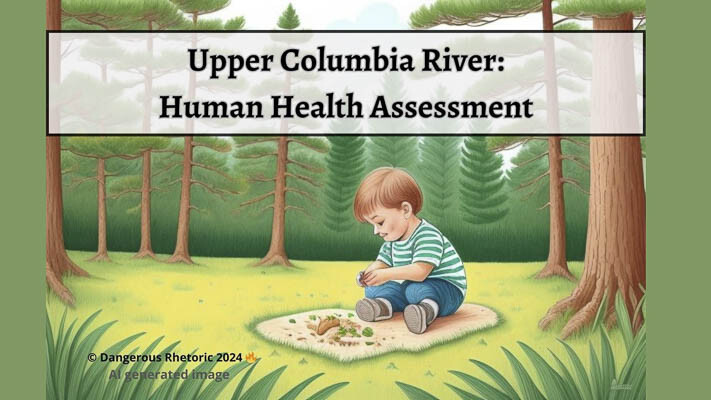
Nancy Churchill offers the fourth of a series of articles about the proposed EPA Superfund site on the upper Columbia River
Nancy Churchill
Dangerous Rhetoric
This is part four of a series of articles about the proposed EPA Superfund site on the upper Columbia River. The previous articles are available at https://nancydchurchill.substack.com/. In this article, we will dive deeper into data provided in the March 2024 Human Health Assessment.

As part of the work being done after the 2006 settlement agreement between Teck American and the EPA, several intensive scientific studies have been underway. The work on these studies is being done under the supervision of the EPA. In addition to the Human Health Risk Assessment which documents the impact of the pollution on humans, a baseline ecological risk assessment is underway. After that is published, there will be a feasibility study, which will outline the proposed future remediation actions to be taken. The studies will conclude with EPA’s selection of final remedial actions following which EPA will issue a final record of decision (ROD). At this time, it is anticipated that EPA will complete the ROD in 2028.
Who and what was studied?
The release of the Human Health Risk Assessment is significant, because it seems to have been used to justify the proposed listing of the Upper Columbia River on the National Priorities (Superfund) list.
According to the executive summary, “Multiple rounds of data have been collected at the site over the past 15 years, including samples of UCR surface water, beach sediment, soil, air, and tissue (fish, macroinvertebrates, and plants).” Chemicals of potential concern (COPCs) were found in surface water, public and residential beaches, soil in the “uplands” and in wild plants, birds, fish and wild game. COPCs included lead, arsenic, zinc, cadmium, copper, and mercury.
Exposure was measured in several population groups: residents, outdoor workers, recreational visitors to Lake Roosevelt, Colville High Intensity Resource Users, and the Spokane Tribe of Indians.
Results of the Human Health Risk Assessment
According to the HHRA Executive Summary, “The following generalizations can be made based on the results of the HHRA for the residential, recreational, and worker populations:
“Residential exposure to soil sampled from 588 residential areas and 142 larger randomly selected areas exceeded lead and non-lead risk benchmarks. Removal actions were taken between 2015 and 2018 at 18 properties that were heavily contaminated. Lead in soil poses the greatest risk, the soil is generally more contaminated in areas that are closer to the international border and closer to the river, and undeveloped lands are generally more contaminated than developed (residential) land.
“None of the three metals (arsenic, cadmium, and lead) monitored in air from 2002 to 2009 near Northport or at the international border exceeded risk benchmarks.
“Open public beaches and the UCR are safe for recreation. Bossburg Flat Beach is closed to the public due to high lead levels, and the State of Washington is remediating the Northport waterfront. Human health risks from recreating in river water and sediment are low in other areas of the river.
“Fish, other than sucker, have low levels of lead…Fish consumers are encouraged to follow the Washington Department of Health Fish Advisories for the UCR and Lake Roosevelt.
“Risk to outdoor workers is minimal. Upland soil does not present a risk to outdoor workers.”
And finally, regarding exposure to airborne emissions from the Teck smelter over the years, “Exposure to airborne contaminants from the Teck smelter do not pose an unacceptable risk to site residents, recreators, or workers.”
Protecting the children?
Let’s consider the concern regarding children’s exposure to lead. Lead exposure risk, for both current and future children is estimated based on soil levels of lead. It’s a guess, not something based on testing actual children living in or visiting the area.
We should also consider that Northport is a very small, remote town. We’re talking about a small population of children who might be impacted. Why would the entire upper 150-mile reach of the upper Columbia River be designated as a superfund fund because of this tiny population?
However, we don’t want any children to be endangered! Why haven’t the children living in the exposure areas had ANY blood testing done? Parents would be worried about their children if the EPA notified them of the lead exposure risk.
Unfortunately, despite the supposed urgency of the problem of lead exposure, the EPA has made NO efforts to get the local children evaluated. Why? Don’t they care about the children? Or, are they simply using the children as an excuse to justify the superfund designation?
More questions than answers
The fish are safe to eat, the water is safe for recreation, the most contaminated problem areas have already been remediated, and children do NOT appear to be in any immediate danger.
Reviewing the HHRA Executive Summary leaves me with many questions about the timing of the EPA’s proposal for a superfund site. Since the worst properties have already been remediated, how much more remains to be done in the uplands? This question will probably be answered by the baseline ecological risk assessment.
Without knowing the actual scope of the remaining problems, we don’t know what future remediation actions are necessary or appropriate. These points will be answered by the future feasibility study. Given these two important reports are outstanding, why would the EPA move forward on a superfund decision RIGHT NOW?
In our next few articles in this series, we’re going to look at the state, tribal, and local governments impacted by the Superfund proposal. Then we’ll take a look at the Superfund rules and discover how to make a comment on the proposal. We want to understand this topic well enough to make impactful comments to the EPA.
Nancy Churchill is a writer and educator in rural eastern Washington State, and the state committeewoman for the Ferry County Republican Party. She may be reached at DangerousRhetoric@pm.me. The opinions expressed in Dangerous Rhetoric are her own. Dangerous Rhetoric is available on thinkspot, Rumble and Substack.
Also read:
- Opinion: Vancouver’s new $30 rental fee will increase rents in the cityMark Harmsworth argues Vancouver’s new $30 rental unit fee will raise rents, discourage investment, and worsen affordability, urging the city to repeal the policy and pursue market-driven housing solutions.
- Opinion: The right speed to exitDoug Dahl of Target Zero explains that while exit-only freeway lanes follow the posted speed limit, drivers are legally required to reduce speed based on safety conditions as they approach offramps.
- Letter: It’s time for Vancouver to choose changeVancouver resident Michael Jelineo calls for new leadership in the city and voices his support for Justin Forsman in the mayoral race, urging others to back change.
- Opinion: ‘Vilifying broad swaths of Americans’Editor Ken Vance reflects on troubling posts by public defender Renee Alsept and shares a thoughtful perspective from longtime attorney Brad Andersen on ethics, discourse, and professionalism.
- POLL: Should the county update its Human Resources policy to include personal social media accounts of employees in sensitive roles?This week’s Clark County Today poll asks whether the county should update its Human Resources policy to include personal social media accounts of employees in sensitive roles, following concerns over online conduct.










